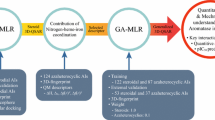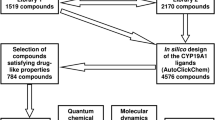Abstract
CYP450 aromatase catalyzes the terminal and rate-determining step in estrogen synthesis, the aromatization of androgens, and its inhibition is an efficient approach to treating estrogen-dependent breast cancer. Insight into the molecular basis of the interaction at the catalytic site between CYP450 aromatase inhibitors and the enzyme itself is required in order to design new and more active compounds. Hence, a combined molecular docking–molecular dynamics study was carried out to obtain the structure of the lowest energy association complexes of aromatase with some third-generation aromatase inhibitors (AIs) and with other novel synthesized letrozole-derived compounds which showed high in vitro activity. The results obtained clearly demonstrate the role of the pharmacophore groups present in the azaheterocyclic inhibitors (NSAIs)—namely the triazolic ring and highly functionalized aromatic moieties carrying H-bond donor or acceptor groups. In particular, it was pointed out that all of them can contribute to inhibition activity by interacting with residues of the catalytic cleft, but the amino acids involved are different for each compound, even if they belong to the same class. Furthermore, the azaheterocyclic group strongly coordinates with the Fe(II) of heme cysteinate in the most active NSAI complexes, while it prefers to adopt another orientation in less active ones.

3D structure of the Michaelis complex for Androstenedione-Aromatase


















Similar content being viewed by others
References
Simpson ER, Mahendroo MS, Means GD, Kilgore MW, Hinshelwood MM, Graham-Lorence S, Amarneh B, Ito Y, Fisher CR, Michael MD, Mendelson CR, Bulun SE (1994) Aromatase cytochrome P450, the enzyme responsible for estrogen biosynthesis. Endocr Rev 15:342–355
Brueggmeir RW, Hackett JC, Diaz-Cruz ES (2005) Aromatase inhibitors in the treatment of breast cancer. Endocr Rev 26:331–345
Plourde PV, Dyroff M, Dowsett M, Demers L, Yates R, Webster A (1995) Arimidex: a new oral, once-a-day aromatase inhibitor. J Steroid Biochem Mol Biol 53:175–179
Lipton A, Demers LM, Harvey HA, Kambic KB, Grossberg H, Brady C et al (1995) Letrozole (CGS 20267). A phase I study of a new potent oral aromatase inhibitor of breast cancer. Cancer 75:2132–2138
Chen S, Zhang F, Sherman MA, Kijma I, Cho M, Yuan YC, Toma Y, Osawa Y, Zhou D, Eng ET (2003) Structure-function studies of aromatase and its inhibitors: a progress report. J Steroid Biochem Mol Biol 86:231–237
Gosh D, Griswold J, Erman M, Pangborn W (2009) Structural Basis for androgen specificity and estrogen synthesis in human aromatase. Nature 458:219–223
Gosh D, Griswold J, Erman M, Pangborn W (2010) X-ray structure of human aromatase reveals an androgen-specific acive site. J Steroid Biochem Mol Biol 118:197–202
Hong Y, Li H, Yuan YC, Chen S (2009) Molecular characterization of aromatase. Ann NY Acad Sci 1155:112–120
Paoletta S, Stevenson GB, Wildeboer D, Eherman TM, Hylands PJ, Barlow DJ (2008) Screening of herbal constituents for aromatase inhibitory activity. Bioorg Med Chem 16:8466–8470
Takahashi M, Yamashita K, Numazawa M (2010) Probing the binding pocket of the active site of aromatase with 2-phenylaliphatic androsta-1,4-3,17-dione steroids. Steroids 75:330–337
Cassidy CE, Setzer WN (2010) Cancer-relevant biochemical targets of cytotoxic Lonchocarpus flavonoids: a molecular docking analysis. J Mol Model 16:311–326
Jackson T, Lawrence LW, Trusselle MN, Purhoit A, Reed MJ, Potter BVL (2008) Non-steroidal aromatase inhibitors based on a biphenyl scaffold: synthesis, in vitro SAR and molecular modeling. ChemMedChem 3:603–618
Chen S, Kao YC, Laughton CA (1997) Binding characteristics of aromatase inhibitors and phytoestrogens to human aromatase. J Steroid Biochem Mol Biol 61:107–115
Oliveira AA, Ramalho TC, da Cunha EFF (2009) QSAR study of androstenedione analogs as aromatase inhibitors. Lett Drug Des Discov 6:554–562
Favia AD, Cavalli A, Masetti M, Carotti A, Recanatini M (2006) Three dimensional model of the human aromatase enzyme and density functional parametrization of the iron containing protoporphyrin IX for a molecular dynamics study of heme-cysteinato cytochromes. Proteins 62:1074–1087
Graham-Lorence S, Amarneh B, White R.E, Peterson JA, Simpson ER (1995) A three dimensional model of aromatase cytochrome P450*. Protein Sci 4:1065–1080
Williams PA, Cosme J, Ward A, Angove HC, Matak Vinkovic D, Jhoti H (2003) Crystal structure of human cytochrome P450 2 C9 with bound warfarin. Nature 424:464–468
Roy PP, Roy K (2010) Docking and 3D-QSAR studies of diverse classes of human aromatase (CYP19) inhibitors. J Mol Model 16:1597–1616
Wood PM, Lawrence Woo LW, Labrosse JR, Trusselle MN, Abbate S, Longhi G, Castiglioni E, Lebon F, Purohit A, Reed MJ, Potter BVL (2008) Chiral aromatase and dual aromatase-steroid sulfatase inhibitors from the letrozole template: synthesis, absolute configuration, and in vitro activity. J Med Chem 51:4226–4238
Pettersen EF, Goddard TD, Huang CC, Couch GS, Greenblatt DM, Meng EC, Ferrin TE (2004) UCSF Chimera—a visualization system for exploratory research and analysis. J Comput Chem 13:1605–1612
Onufriev A et al. (2011) H++ server homepage. http://biophysics.cs.vt.edu/
Thomson EA, Siiteri PK (1974) Utilization of oxygen and reduced nicotinamide adenine dinucleotide phosphate by human placental microsomes during aromatization of androstenedione. J Biol Chem 249:5364–5372
O’Neal Johonston J (1998) Aromatase inhibitors. Crit Rev Biochem Mol Biol 33:375–405
Aktar M, Calder DL, Corina DL, Wright JN (1982) Mechanistic studies on C-19 demethylation in estrogen biosynthesis. Biochem J 201:569–580
Aktar M, Njar VC, Wright JN (1993) Mechanistic studies on aromatase and related C-C bond cleaving P-450 enzymes. J Steroid Biochem Mol Biol 44:375–387
Silgar SG, Murray RI (1986) In: de Montellano PR Ortiz (ed) Cytochrome P-450: structure, mechanism and biochemistry, 3rd edn. Plenum, New York, p 429
Poulos TL (1986) In: de Montellano PR Ortiz (ed) Cytochrome P-450: structure, mechanism and biochemistry, 3rd edn. Plenum, New York, p 505
Waxman DJ (1986) In: de Montellano PR Ortiz (ed) Cytochrome P-450: structure, mechanism and biochemistry, 3rd edn. Plenum, New York, p 525
Beunsen DD, Carrell HL, Covey DF (1987) Metabolism of 19-methyl-substituted steroids by human placental aromatase. Biochemistry 26:7833
Hackett JC, Brueggenmeier RW, Hadad CM (2005) The final catalytic step of cytochrome P450 aromatase: a density functional theory study. J Am Chem Soc 127:5244–5237
Still WC, Tempczyk A, Hawley RC, Hendrickson T (1990) Semianalytical treatment of solvation for molecular mechanics and dynamics. J Am Chem Soc 12:6127–6129
Mohamadi F, Richards NGJ, Guida WC, Liskamp R, Lipton M, Caufied C, Chang G, Hendrickson T, Still WC (1990) Macromodel—an integrated software system for modeling organic and bioorganic molecules using molecular mechanics. J Comput Chem 11:440–467
Weiner JS, Kollman PA, Case DA, Singh UC, Ghio C, Alagona G, Profeta S, Weiner PA Jr (1984) A new force field for molecular mechanical simulation of nucleic acids and proteins. J Am Chem Soc 106:765–784
Morris GM, Huey R, Lindstrom W, Sanner MF, Belew RK, Goodsell DS, Olson AJ (2009) Autodock4 and AutoDockTools4: automated docking with selective receptor flexibility. J Comput Chem 162:785–791
Huey R, Morris GM, Olson AJ, Goodsell DS (2007) A semiempirical free energy force field with charge-based desolvation. J Comput Chem 28:1145–1152
Huey R, Goodsell DS, Morris GM, Olson AJ (2004) Grid-based hydrogen bond potentials with improved directionality. Lett Drug Des Discov 1:178–183
Oda A, Yamaotsu N, Hirono S (2005) New AMBER force field parameters of heme iron for cytochrome P450s determined by quantum chemical calculations of simplified models. J Comput Chem 26:818–826
Leimkuhler B, Skeel R (1994) Symplectic numerical integrators in constrained Hamiltonian systems. J Comput Phys 112:117–125
Brunetti L, Galeazzi R, Orena M, Bottoni A (2008) Catalytic mechanism of L,L-diaminopimelic acid with diaminopimelate epimerase by molecular docking simulations. J Mol Graph Model 26:1082–1090
Melchiorre C, Andrisano V, Bolognesi ML, Budriesi R, Cavalli A, Cavrini V, Rosini M, Tumiatti V, Recanatini M (1998) Acetylcholinesterase noncovalent inhibitors based on a polyamine backbone for potential use against Alzheimer’s disease. J Med Chem 41:4186–4189
Rampa A, Bisi A, Valenti P, Recanatini M, Cavalli A, Andrisano V, Cavrini V, Fin L, Buriani A, Giust P (1998) Acetylcholinesterase inhibitors: synthesis and structure–activity relationships of omega-[N-methyl-N-(3-alkylcarbamoyloxyphenyl)-methyl]aminoalkoxyheteroaryl derivatives. J Med Chem 41:3976–3986
Calvaresi M, Garavelli M, Bottoni A (2008) Computational evidence for catalytic mechanism of glutamine cyclase, a DFT investigation. Proteins 73:527–538
Stenta M, Calvaresi M, Altoè P, Spinelli D, Garavelli M, Galeazzi R, Bottoni A (2009) The catalytic mechanism of DAP epimerase: a QM/MM investigation. J Chem Theory Comput 5:1915–1930
Thurlimann B, Keshaviah A, Coates AS, Mouridsen H, Mauriac L, Forbes JF, Paridaens M, Castiglione-Geretsh M, Gelber RD, Rabaglio M, Smith I, Wardely A, Price KN, Goldhirsh A (2005) A comparison of letrozole and tamoxifen in postmenopausal women with early breast cancer. N Engl J Med 353:2747–2757
Jakesz R, Jonet W, Gnant M, Mittleboeck M, Grail R, Tausch C, Hilfrich J, Kwasny W, Menzel C, Samonigg H (2005) Switching of postmenopausal women with endocrine-responsive early breast cancer to anastrozole after 2 years’ adjuvant tamoxifen: combined results of ABCSG trial 8 and ARNO 95 trial. Lancet 366:455–462
Furet P, Batzl C, Bathnagar A, Francotte E, Rihs G, Lang M (1993) Aromatase inhibitors: synthesis, biological activity, and binding mode of azole-type compounds. J Med Chem 36:1393–1400
Jackson T, Lawrence Woo LW, Trusselle MN, Purohit A, Reed MJ, Potter BVL (2008) Non-steroidal aromatase inhibitors based on a biphenyl scaffold: synthesis, in vitro SAR and molecular modeling. ChemMedChem 3:603–618
Neves MAC, Dinis TCP, Colombo G, Sá e Melo ML (2009) Fast three dimensional pharmacophore virtual screening of new potent nonsteroid aromatase inhibitors. J Med Chem 52:143–150
Cole PA, Robinson CH (1990) Mechanism and inhibition of cytochrome P-450 aromatase. J Med Chem 33:2933–2942
Hong Y, Cho M, Yuan YC, Chen S (2008) Molecular basis for the interaction of four different classes of substrates and inhibitors with human aromatase. Biochem Pharm 75:1161–1169
Lawrence Woo LW, Bubert C, Sutcliffe OB, Smith A, Chander SK, Mahon MF, Purohit A, Reed MJ, Potter BVL (2007) Dual aromatase–steroid sulfatase inhibitors. J Med Chem 50:3540–3560
Bikadi Z, Hazai E (2009) Application of the PM6 semi-empirical method to modeling proteins enhances docking accuracy of AutoDock. J Chem Inf 1:15–31
Galeazzi R (2009) Molecular dynamics as a tool in rational drug design: current status and some major applications. Curr Comput Aided Drug Des 5:225–240
Author information
Authors and Affiliations
Corresponding author
Rights and permissions
About this article
Cite this article
Galeazzi, R., Massaccesi, L. Insight into the binding interactions of CYP450 aromatase inhibitors with their target enzyme: a combined molecular docking and molecular dynamics study. J Mol Model 18, 1153–1166 (2012). https://doi.org/10.1007/s00894-011-1144-y
Received:
Accepted:
Published:
Issue Date:
DOI: https://doi.org/10.1007/s00894-011-1144-y




